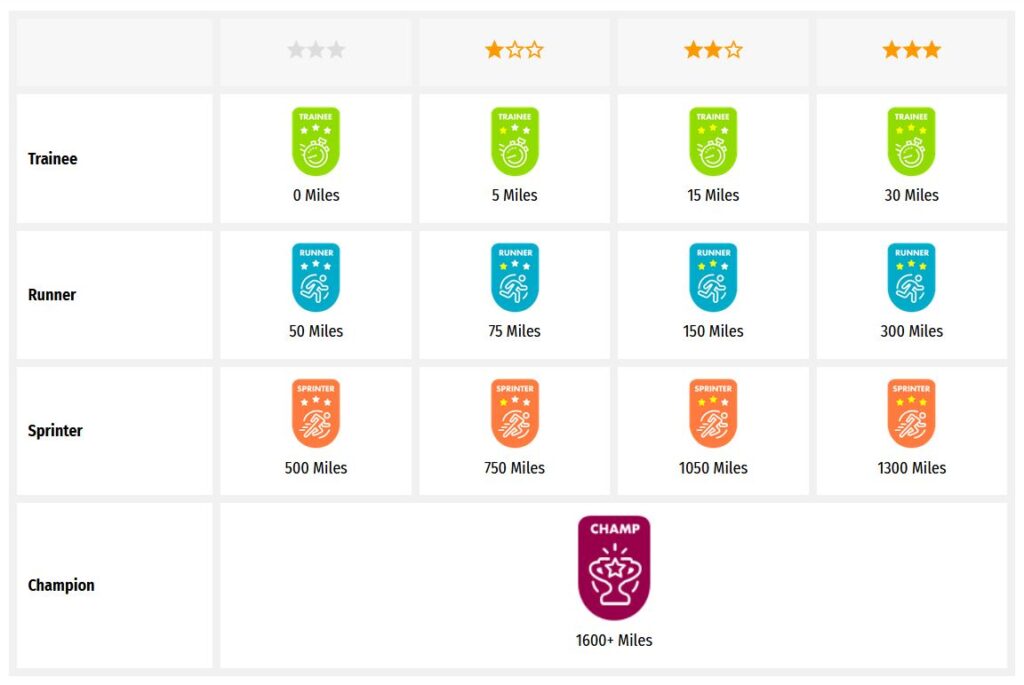Someone else is currently editing this document
Only one person can work on a document at a time
HTR TRANSCRIPTION
Royal Exchange
Wednesday 1511 NNovember 1815.
our Committee having examined the situation
of the Dublin Tavern, are of opinion that an open
are commencing in a paint at the passage which
runs between tho said Tavern and the Dublin Library
and carrying on the line of the front of said Library
till it intersects a line drawn paralel with the front
of the Tavrn and at the pame distance from id as the
rails rom in front of the ballast office and returning
it down D'Olier Street us far as the door of the
Faurn would be io inconvenience to the Public and
would correspond with the other Buildings
Resolved that this Board dodgree with their
Committee as to the apen drea in front to Burgh
Quay, - and thequestion being put from the chair
That said open drea should return down D'Olier
Street as far as the door of the Favern, it being
peniously proposed it should be only four feet and half
suide in the clear.
It was carried in the affirmative
Ayes for the open drea fourand half feet wide mitheclear five
Noes
Three
Mr. Gore and Mr. C. C: Beresford having come in after the
division, desired to express their concurrence in the decision
North
Language(s) of Transcription
LOCATION
Dublin (county) (53.4064, -6.29594)
Story Location
ABOUT THIS DOCUMENT
Document Date
Document Type
Document Description
Language of Description
Keywords
External Web Resources
People
William Gore
Description: Colonel
Charles Cobbe Beresford
Description: Reverend
STORY INFORMATION
Title
Wide Streets Commission Minutes Volume 28
Creator
Wide Streets Commission
Contributor
Wide Streets Commission
Dublin City Library and Archive
Publisher
Dublin City Library and Archive
Type
Text
Rights
Dublin City Council
Language
eng
English
Identifier
#z6044n50r
LandingPage
https://www.europeana.eu/item/615/_z6044n50rCountry
Ireland
DataProvider
Dublin City Library and Archive
DatasetName
615_615_Dublin_City_Library_and_Archive
Begin
30 August 1815
1801-01-01
End
6 November 1816
1900-12-31
Language
ga
Created
2022-03-17T12:22:30.666Z
2022-03-17T12:22:35.648372Z
2022-03-17T12:22:35.648873Z
file:///home/vcap/app/#30th_August_1815_-_6th_November_1816Story Description
373 pp
TRANSCRIPTION
LOCATION
DESCRIPTION
PEOPLE
STORY INFO
TUTORIAL
65
Royal Exchange
Wednesday 15th November 1815
Your Committee having examined the situation
of the Dublin Tavern;_are of Opinion that an open
area commencing in a point at the passage which
runs between the said Tavern and the Dublin Library
and carrying on the line of the front of said Library
till it intersects a line drawn parabel with the front
of the Tavern and at the same distance from it as the
 now in front of the Ballast Office and returning
now in front of the Ballast Office and returning
ot down D\'Olier Street as far as the door of the
Tavern, would be no inconvenience to the Public and
would correspond with the other Buildings._
Resolved That this Board do agree with their
Committee as to the open area in front to Burgh
Quay._ And the question being put from the Chair
that said open area should "return down D\'Olier
Street as far as the door of the Tavern". it being
previously proposed it should be only four feet and half
wide in the clear._
It was carried in the affirmative._
A Yes for the open area four and half feet wide with the clear Five
Noes . . .. . .. . .. .. . . . ... .. . . . .. .. . . . . . . . . . . . . . .. ... . .. . ... . . . Three
Mr Gore and Mr C. C. Beresford having come in after the
division, desired to express their convenience in the decision
North
- English (English)
Royal Exchange
Wednesday 1511 NNovember 1815.
our Committee having examined the situation
of the Dublin Tavern, are of opinion that an open
are commencing in a paint at the passage which
runs between tho said Tavern and the Dublin Library
and carrying on the line of the front of said Library
till it intersects a line drawn paralel with the front
of the Tavrn and at the pame distance from id as the
rails rom in front of the ballast office and returning
it down D'Olier Street us far as the door of the
Faurn would be io inconvenience to the Public and
would correspond with the other Buildings
Resolved that this Board dodgree with their
Committee as to the apen drea in front to Burgh
Quay, - and thequestion being put from the chair
That said open drea should return down D'Olier
Street as far as the door of the Favern, it being
peniously proposed it should be only four feet and half
suide in the clear.
It was carried in the affirmative
Ayes for the open drea fourand half feet wide mitheclear five
Noes
Three
Mr. Gore and Mr. C. C: Beresford having come in after the
division, desired to express their concurrence in the decision
North
Language(s) of Transcription
English Translation
Transcription History
65 Royal Exchange Wednesday 15th November 1815 Your Committee having examined the situation of the Dublin Tavern;_are of Opinion that an open area commencing in a point at the passage which runs between the said Tavern and the Dublin Library and carrying on the line of the front of said Library till it intersects a line drawn parabel with the front of the Tavern and at the same distance from it as the now in front of the Ballast Office and returning ot down D\'Olier Street as far as the door of the Tavern, would be no inconvenience to the Public and would correspond with the other Buildings._ Resolved That this Board do agree with their Committee as to the open area in front to Burgh Quay._ And the question being put from the Chair that said open area should "return down D\'Olier Street as far as the door of the Tavern". it being previously proposed it should be only four feet and half wide in the clear._ It was carried in the affirmative._ A Yes for the open area four and half feet wide with the clear Five Noes . . .. . .. . .. .. . . . ... .. . . . .. .. . . . . . . . . . . . . . .. ... . .. . ... . . . Three Mr Gore and Mr C. C. Beresford having come in after the division, desired to express their convenience in the decision North
65 Royal Exchange Wednesday 15th November 1815 Your Committee having examined the situation of the Dublin Tavern;_are of Opinion that an open area commencing in a point at the passage which runs between the said Tavern and the Dublin Library and carrying on the line of the front of said Library till it intersects a line drawn parabel with the front of the Tavern and at the same distance from it as the now in front of the Ballast Office and returning ot down D\'Olier Street as far as the door of the Tavern, would be no inconvenience to the Public and
English Translation
Automatically Identified Enrichments
Verify Automatically Identified Enrichments
Verify Automatically Identified Locations
Verify Automatically Identified Persons
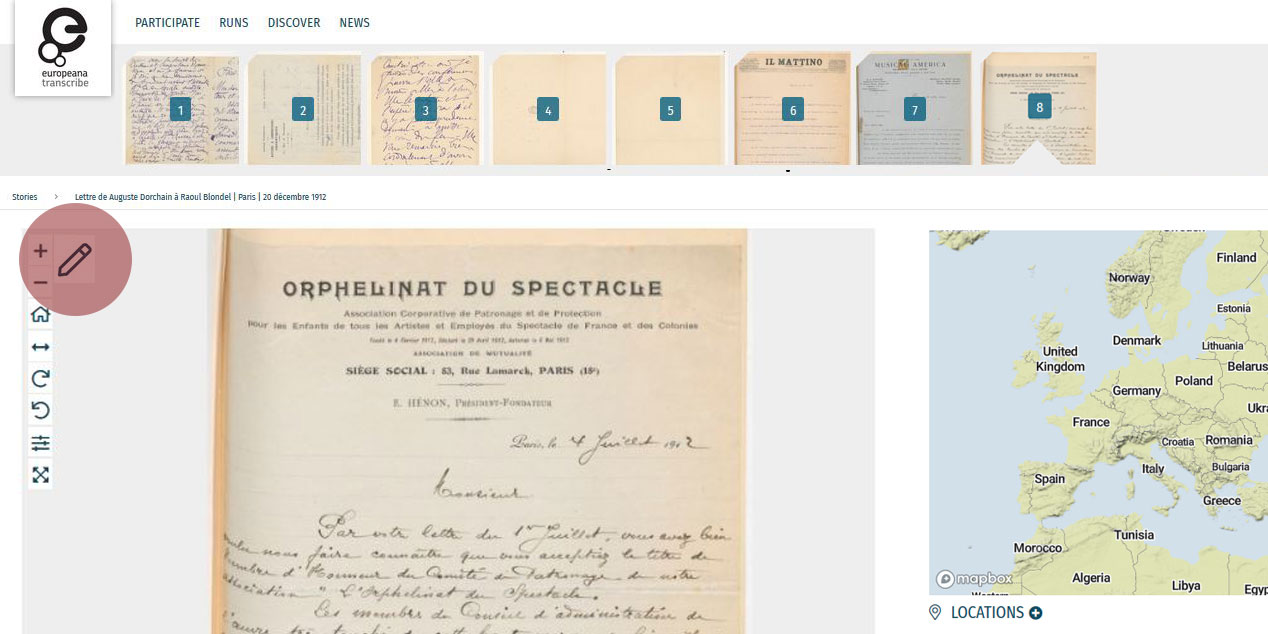
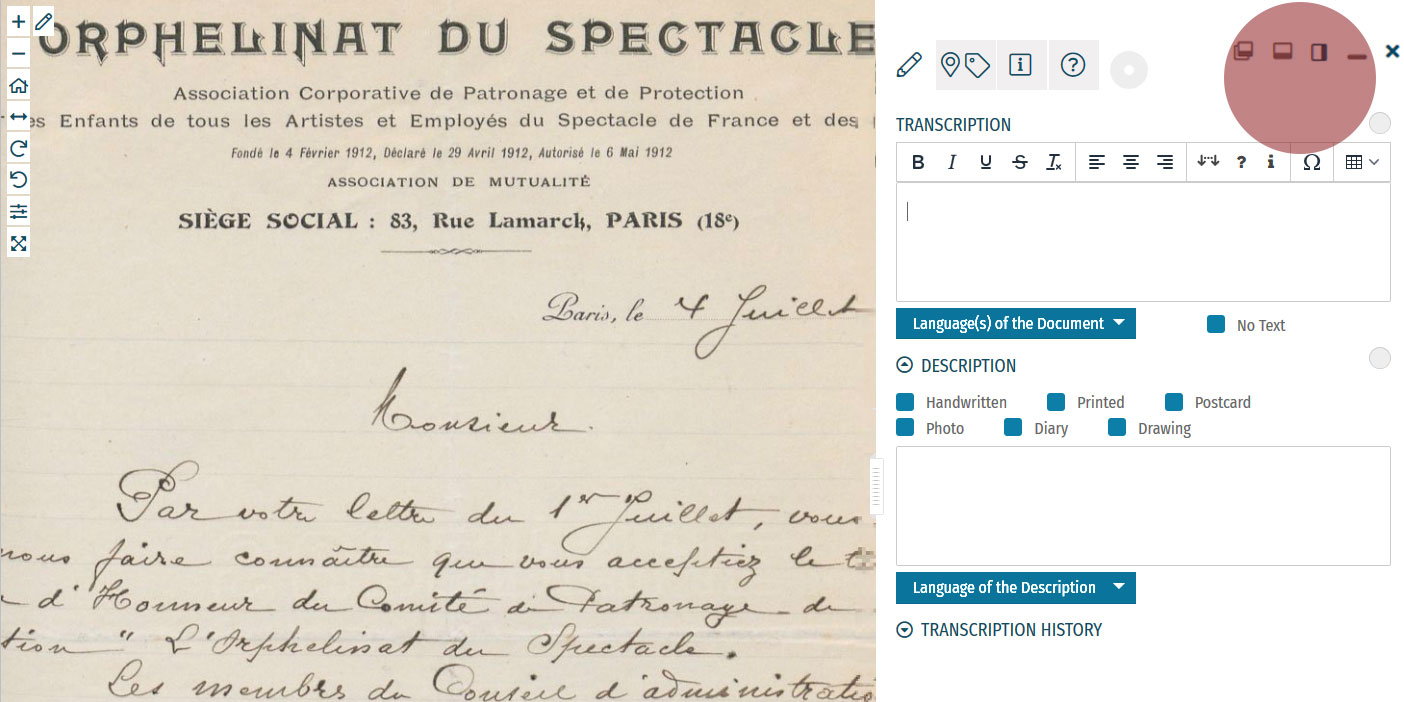
Enrichment Mode
Edit your workspace view by using the top-right menu.
You can have the white Activity Panel docked to the right (default) , to the bottom , or as an independent overlay . If you just want to view the image, you can hide the panel using the minimise button , and then re-open it with the pen button. Adjust the size and position of your Activity Panel according to your preferences.
You enrich documents by following a step-by-step process.
Make sure you regularly save your enrichments in each step to avoid the risk of losing your work.

Step 1: Transcription
To start a transcription, select the transcription tab at the top menu of the Activity Panel. Click inside the box underneath the heading TRANSCRIPTION and start writing your transcription. When needed, use the toolbar to format your text and to add special characters and tables. A guide to the transcription toolbar is available in the Formatting section of this tutorial.
Identify the language(s) of the text using the dropdown list under the transcription box. You can select multiple languages at once.
If the item has no text to transcribe, tick the checkbox ‘No Text’.
Once you have finished your transcription, click SAVE.
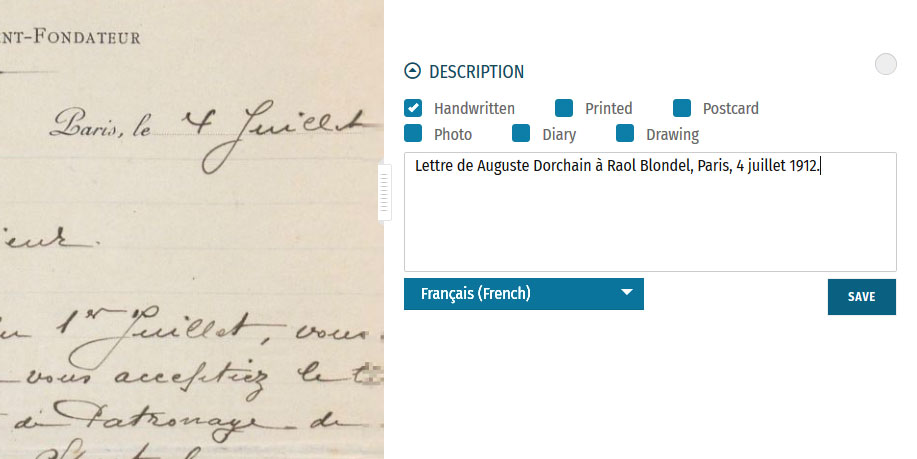
Step 2: Description
You can add a description to the item underneath the Transcription section.
The first task is to identify what type of document the item is: a handwritten or printed document, a postcard, photo, drawing and/or part of a diary. Tick the category which best applies to the item. Multiple categories can be selected at once.
The second task is to write a description of the contents. Click inside the box underneath the heading DESCRIPTION. Here, you can write what the item is, what it is about, and specify the images and objects that appear in the item.
Identify the language of the description text that you wrote using the dropdown list underneath. You can only select one language.
Once you have finished your description, click SAVE.
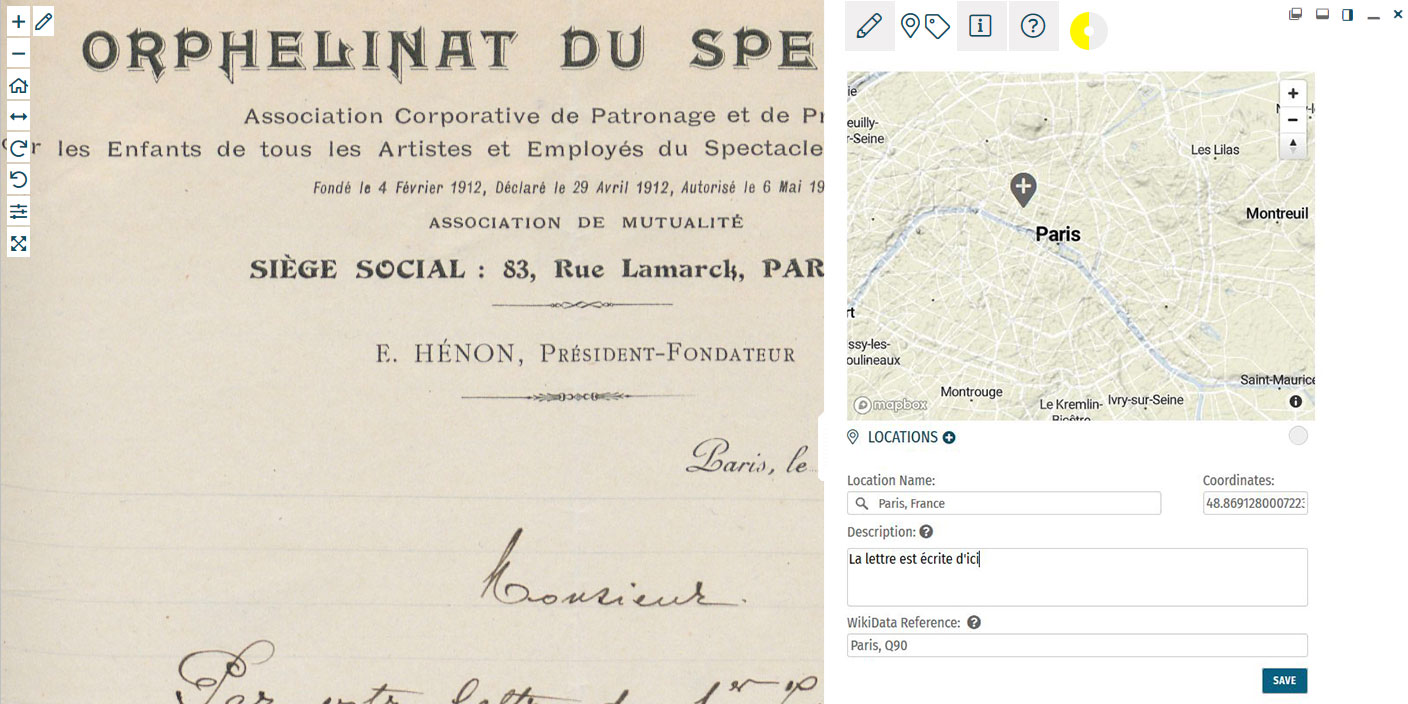
Step 3: Location
If you find a location mentioned or recognise a place in the item, you can create a geotag and pin it to the item map. Multiple locations can be attached to the item. To tag locations, select the tagging tab at the top menu of the Activity Panel. Click the plus next to the heading LOCATIONS. Type the location into the search bar and select the result that best applies. A new pin will be placed into the map. The location name should be a clear georeference, e.g. a country, city or address. Make adjustments to the location name if necessary. You can also adjust the position of the pin by dragging it on the map. If you want to add further details to the location, you can write a (short) description. This could include extra information about the geotag (e.g. the building name or a significant event that took place at the location) or the relevance of the place to the item (e.g. the hometown of the author). You can also add a Wikidata reference to link the location to a stable source. Search for the reference using the Wikidata fields. Once you have finished your location tag, click SAVE. You can find the place(s) tagged to the item in grey at the bottom of the Location(s) section.Step 4: Tagging
Below the Locations section is the Tagging section, where you can add the following annotations:
 Document Date:
Document Date:Here, you can add dates that correspond to the item. This could include the dates mentioned in the text (e.g. in diary pages), the date of a related historical event (e.g. the end of WWI), or when the item was created (e.g. from a dated signature on an illustration). You can either define this as a single date or as a longer time frame.
To tag dates to the item, write the start and end dates in DD/MM/YYYY format in the fields or select the dates by clicking on the calendar.
If you only have one date to add, insert the same date into both start and end fields.
If you don’t know the exact days, you can also tag the date on the scale of months (MM/YYYY) or years (YYYY).
Once you have finished your date tag, click SAVE DATE.
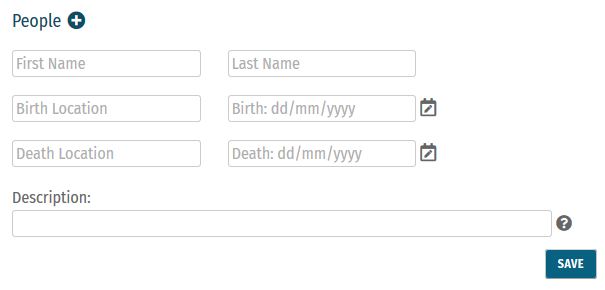 People:
People:People mentioned as creators or subjects in the item can also be tagged. Depending on the information you might have, you can enter the person’s first and last names, as well as their dates of birth and death. There is also the option to write a short description of the person, explaining who they are or their relevance to the item, e.g. the person’s occupation or their relation to another tagged person.
Multiple people can be tagged to one item.
Once you have finished your person tag, click SAVE.
 Keywords:
Keywords:Here, you can freely add keywords related to the topic and content of the item. This could include particular themes (e.g. art, music, war), subjects (e.g. children, cooking, France), or particular historical affiliations (e.g. 20th century, Austro-Hungarian Empire, Fall of the Iron Curtain).
Multiple keywords can be added and they can be written in any language.
Write your keyword tag into the field and click SAVE.
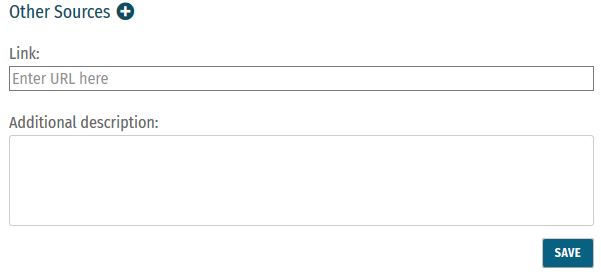 Other Sources:
Other Sources:External websites with information about the item’s content can be linked here. This could include links to further data about a person mentioned, a particular historical event or links to digital versions of newspapers that appear in photos or clippings in a notebook.
To add a link, click the plus next to the heading ‘Other Sources’. Enter the URL into the Link field, and write a short description of this link in the Additional Description field.
Multiple links can be tagged to one item.
Once you have finished your tag, click SAVE.
Step 5: Mark for Review
Once you have saved your contribution, the task will automatically change to the Edit status. If you think the task is finished, you can mark it for review. Note that you have to be at Runner level or above to do this (see: Miles and Levels). Click on the yellow circle next to the section heading and select Review in the list that appears. The task now needs to go under Review by another volunteer.Formatting
Review
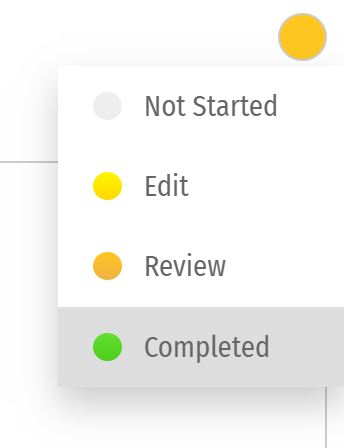 All enrichments need to be edited and reviewed by more than one volunteer to ensure that they are as accurate as possible.
Only Sprinters and Champions can edit tasks in the Review stage and mark them as Complete. (see: Miles and Levels)
You can review a task (Transcription, Description, Locations, or Tagging) when the circle next to the heading is coloured orange .
During the review process, pay close attention to the following requirements:
All enrichments need to be edited and reviewed by more than one volunteer to ensure that they are as accurate as possible.
Only Sprinters and Champions can edit tasks in the Review stage and mark them as Complete. (see: Miles and Levels)
You can review a task (Transcription, Description, Locations, or Tagging) when the circle next to the heading is coloured orange .
During the review process, pay close attention to the following requirements:
-
- Transcription: The complete text in the item has been properly transcribed and the transcription is formatted as accurately as possible. The correct language(s) are selected and the transcription contains no missing or unclear icons.
-
- Description: The description is accurate and detailed (especially items without text to transcribe, e.g. photos), and the appropriate categories have been ticked.
-
- Location(s): All locations have been correctly tagged. The location name is accurate and matches the coordinates and the pin on the map. The description is clear and concise, and the Wikidata reference (if any) is correct.
-
- Tagging: Document dates are completed and as precise as possible. All mentioned people are tagged and their data is correct. All added keywords are applicable to the item, and other sources have accurate information and functioning links.
Completion Statuses
| GREY |
| 1. NOT STARTED |
| Tasks have not been started. |
| YELLOW |
| 2. EDIT MODE |
| Tasks have been started, but not yet finished. Additions and edits can still be made. |
| ORANGE |
| 3. REVIEW |
| Tasks are finished, but need final review by Sprinter or Champion transcribers. |
| GREEN |
| 4. COMPLETED |
| Tasks have been fully completed and reviewed. No further changes need to be made. |
Miles and Levels
Transcribathon is a competitive marathon. You do not enrich documents alone, but compete and work with other volunteers to ensure the quality of your work. When you first create a Transcribathon account, you only have the ability to start and edit tasks. The more you enrich documents, the closer you become to advancing to a higher level, which can unlock abilities like reviewing and completing tasks.| Level | Abilities |
|---|---|
| Trainee | Basic abilities: start and edit tasks |
| Runner | Basic abilities, mark finished tasks for review |
| Sprinter | All Runner abilities, mark reviewed annotations as completed |
| Champion | All Sprinter abilities, mark reviewed transcriptions as completed |
| Tasks | Miles Received |
|---|---|
| Transcription | 1 Mile for every 300 characters transcribed |
| Description | 1 Mile for every 5 Descriptions added |
| Location | 1 Mile for every 5 Locations added |
| Tagging | 1 Mile for every 5 Tags added |
| Reviewing | 1 Mile for every 10 items marked as complete |
